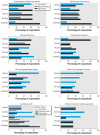Current and future applications of toxicogenomics: Results summary of a survey from the HESI Genomics State of Science Subcommittee
- PMID: 20100679
- PMCID: PMC2920921
- DOI: 10.1289/ehp.0901501
Current and future applications of toxicogenomics: Results summary of a survey from the HESI Genomics State of Science Subcommittee
Abstract
Background: In spite of the application of toxicogenomic (TGx) data to the field of toxicology for the past 10 years, the broad implementation and full impact of TGx for chemical and drug evaluation to improve decision making within organizations and by policy makers has not been achieved.
Objectives: The goal of the Health and Environmental Sciences Institute (HESI) Committee on the Application of Genomics to Mechanism-based Risk Assessment was to construct and summarize a multisector survey, addressing key issues and perspectives on the current and future practical uses and challenges of implementing TGx data to facilitate discussions for decision making within organizations and by policy makers.
Methods: An online survey to probe the current status and future challenges facing the field of TGx for drug and chemical evaluation in experimental and nonclinical models was taken by scientists and scientific decision/policy makers actively engaged in the field of TGx within industrial, academic, and regulatory sectors of the United States, Europe, and Japan. For this survey, TGx refers specifically to the analysis of gene expression responses to evaluate xenobiotic exposure in experimental and preclinical models.
Results: The survey results are summarized from questions covering broad areas including technology used, organizational capacity and resource allocation, experimental approaches, data storage and exchange, perceptions of benefits and hurdles, and future expectations.
Conclusions: The survey findings provide valuable information on the current state of the science of TGx applications and identify key areas in which TGx will have an impact as well as the key hurdles in applying TGx data to address issues. The findings serve as a public resource to facilitate discussions on the focus of future TGx efforts to ensure that a maximal benefit can be obtained from toxicogenomic studies.
Figures


Similar articles
-
Toxicogenomics: A 2020 Vision.Trends Pharmacol Sci. 2019 Feb;40(2):92-103. doi: 10.1016/j.tips.2018.12.001. Epub 2018 Dec 26. Trends Pharmacol Sci. 2019. PMID: 30594306 Free PMC article. Review.
-
Current and future use of genomics data in toxicology: opportunities and challenges for regulatory applications.Regul Toxicol Pharmacol. 2011 Nov;61(2):141-53. doi: 10.1016/j.yrtph.2011.07.012. Epub 2011 Aug 5. Regul Toxicol Pharmacol. 2011. PMID: 21840362
-
Toxicogenomics: the challenges and opportunities to identify biomarkers, signatures and thresholds to support mode-of-action.Mutat Res. 2012 Aug 15;746(2):97-103. doi: 10.1016/j.mrgentox.2012.03.002. Epub 2012 Mar 13. Mutat Res. 2012. PMID: 22445948
-
The future of Cochrane Neonatal.Early Hum Dev. 2020 Nov;150:105191. doi: 10.1016/j.earlhumdev.2020.105191. Epub 2020 Sep 12. Early Hum Dev. 2020. PMID: 33036834
-
Toxicogenomics in risk assessment: an overview of an HESI collaborative research program.Environ Health Perspect. 2004 Mar;112(4):417-9. doi: 10.1289/ehp.6674. Environ Health Perspect. 2004. PMID: 15033589 Free PMC article. Review.
Cited by
-
Drivers of and Obstacles to the Adoption of Toxicogenomics for Chemical Risk Assessment: Insights from Social Science Perspectives.Environ Health Perspect. 2020 Oct;128(10):105002. doi: 10.1289/EHP6500. Epub 2020 Oct 28. Environ Health Perspect. 2020. PMID: 33112659 Free PMC article.
-
Utilizing rat kidney gene co-expression networks to enhance safety assessment biomarker identification and human translation.iScience. 2025 Jun 21;28(7):112978. doi: 10.1016/j.isci.2025.112978. eCollection 2025 Jul 18. iScience. 2025. PMID: 40687826 Free PMC article.
-
Toxicogenomics Approaches to Address Toxicity and Carcinogenicity in the Liver.Toxicol Pathol. 2023 Oct;51(7-8):470-481. doi: 10.1177/01926233241227942. Epub 2024 Jan 30. Toxicol Pathol. 2023. PMID: 38288963 Free PMC article. Review.
-
Comparing the Predictivity of Human Placental Gene, microRNA, and CpG Methylation Signatures in Relation to Perinatal Outcomes.Toxicol Sci. 2021 Sep 28;183(2):269-284. doi: 10.1093/toxsci/kfab089. Toxicol Sci. 2021. PMID: 34255065 Free PMC article.
-
From Classical Toxicology to Tox21: Some Critical Conceptual and Technological Advances in the Molecular Understanding of the Toxic Response Beginning From the Last Quarter of the 20th Century.Toxicol Sci. 2018 Jan 1;161(1):5-22. doi: 10.1093/toxsci/kfx186. Toxicol Sci. 2018. PMID: 28973688 Free PMC article. Review.
References
-
- National Research Council. Applications of Toxicogenomic Technologies to Predictive Toxicology and Risk Assessment. Washington, DC: The National Academies Press; 2007. - PubMed
-
- Dressman HK, Berchuck A, Chan G, Zhai J, Bild A, Sayer R, et al. An integrated genomic-based approach to individualized treatment of patients with advanced-stage ovarian cancer. J Clin Oncol. 2007;25(5):517–525. - PubMed
-
- European Medicines Agency. Scientific Guidelines for Human Medicinal Products. 2009. [[accessed 18 December 2009]]. Available: http://www.emea.europa.eu/htms/human/humanguidelines/multidiscipline.htm.
-
- FDA (Food and Drug Administration) Guidance for Industry: Pharmacogenomic Data Submissions—Companion Guidance. Draft Guidance. 2007. [[accessed 18 December 2009]]. Available: http://www.fda.gov/downloads/Drugs/GuidanceComplianceRegulatoryInformati....
MeSH terms
Substances
LinkOut - more resources
Full Text Sources
Miscellaneous

